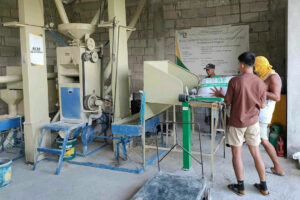THE GOVERNMENT needs to focus on investing in farm infrastructure such as drying, storage, and irrigation facilities to bring rice prices down to P20 per kilo, the Makati Business Club (MBC) said.
Infrastructure investment is more sustainable and efficient than subsidizing rice prices, MBC Chairman Edgar O. Chua told reporters, adding that the key is to reduce farmer reliance on middlemen, many of whom have been providing farmers with storage and inputs.
“Consumers pay a very high price (for rice). We pay almost double what other countries pay, and yet our farmers are getting a very low price for their produce,” Mr. Chua said.
“In between, there are so many middlemen that make a margin. And some of them are lending money, some of them are providing storage facilities, some of them are providing fertilizer, etc. (to farmers),” he added.
“So, what’s needed is to address the inefficiencies in the ecosystem.”
The P20-per-kilo rice program of the Department of Agriculture (DA) has recently been expanded to parts of Luzon and Mindanao, after its initial rollout in selected Visayan provinces on May 1.
The DA hopes to provide subsidized rice to 14 million individuals by September and to keep the program running until the end of the President’s term in 2028.
The subsidy is shared by local government units (LGUs) and Food Terminal, Inc. (FTI).
Before the P20-per-kilo program, the National Food Authority (NFA) was selling rice to LGUs at P33 per kilo under a food security emergency declared in late January. Under this arrangement, it lost about P12 per kilo.
With the price of NFA rice at P33 per kilo, FTI and the LGU will need to pay P6.50 each to close the P13 gap. For government-backed Kadiwa markets, the subsidy is fully paid by the FTI.
Agriculture Secretary Francisco Tiu Laurel, Jr. has said that the FTI will spend P4.5 billion on rice procurement and a further P500 million on logistics and packaging.
To be able to sell rice at P20 per kilo, the government could incur losses worth P10 billion – P12 billion, according to Mr. Laurel.
The DA said earlier this month it’s seeking a P10-billion budget for the FTI to sustain the P20-per-kilo rice program in 2026.
If realized, that would be more than the current P5-billion allocation from the Office of the President’s contingency fund.
Citing previous meetings with Mr. Laurel, Mr. Chua said the MBC is confident that the DA could address systemic issues that keep rice prices high.
“We were pleasantly surprised that he has identified all these issues that are actually hounding our agricultural sector,” he said.
“What would be important would be the political will to address those issues and support from various sectors of society.”
The MBC said it is seeking to promote good governance among farming cooperatives, which it said have been “politicized” as the people running them have been chosen due to their “connections.”
MBC trustee Manolito Tayag said agriculture has not grown significantly over the years, with its members being among the poorest of the population.
“The industry deserves focus from the government. And I think that should come in the form of better budget allocation in order to support growth,” he said.
He said the cure issue is the failed land reform program, which led to the dwindling size of farms, a problem that he said can be addressed by farm consolidation.
The average Philippine farm declined in size by 77% to 0.83 hectares in 2022 from 3.61 hectares in 1970, according to data from the Philippine Statistics Authority. — Kyle Aristophere T. Atienza

